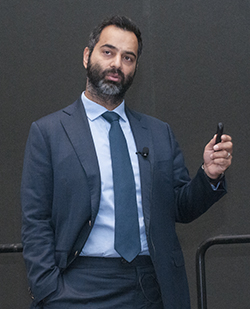
Shahzad Shaefi, M.D., M.P.H.: ‘Pharmacologic prevention and treatment of delirium remains controversial, and non-pharmacologic management of delirium remains the cornerstone of delirium prevention and treatment.’
Delirium is associated with increased morbidity and mortality in older surgical patients, and its causes and treatments are not well understood. Recent research, though, has produced advances in recognition of the condition.
“Many brief delirium screening tools have been developed in the past five years to allow improvement in recognition and risk stratification,” said Shahzad Shaefi, M.D., M.P.H., Saturday. “Along with thorough clinical examination and laboratory testing, additional tools such as imaging and fluid biomarkers are being studied to enhance clinical risk stratification and diagnosis.”
According to the latest research, pharmacologic options for preventing and treating delirium are not yet a reality, said Dr. Shaefi during “Strategies for Identification, Prevention and Treatment of Perioperative Delirium.” Dr. Shaefi is an Assistant Professor in Anaesthesia at Harvard Medical School.
Twenty percent of patients older than age 60 undergoing major surgery suffer from delirium. It remains a clinical diagnosis, and anesthesiologists should be spearheading efforts to learn more about the causes of delirium, he said.
What recent research has shown is that delirium is not transient, and it has long-term consequences. Its consequences are that its links to morbidity and mortality increase hospital stays by two to five days and increase treatment costs by $60,000 per patient a year. The annual cost in the United States to treat delirium is more than $160 billion.
Recent research has identified risk factors for delirium. They include advanced age, pre-existing dementia, central nervous system diseases, functional impairment, multiple comorbidities, multiple medications, and impaired vision or hearing.
Precipitating factors for delirium include the use of psychoactive medications, acute medical problems, exacerbation of chronic medical problems, surgery, pain and environmental change.
Biomarkers for delirium have been studied, and C-reactive proteins and interleukin-1β have been identified, but are not widely used, Dr. Shaefi said. Cytokines are being studied as a potential biomarker.
“Over the next five years, this is where most of the literature will come out,” he said about research of cytokines.
Meanwhile, diagnosis of delirium remains clinical, with the confusion assessment method often used. It assigns points to four features to determine the level of delirium. Features 1 and 2, along with one of the other two features, are required in a diagnosis of delirium. The features are:
- Acute change in mental status with a fluctuating course
- Inattention
- Disorganized thinking
- Altered level of consciousness
Geriatric consultations have been studied as a method to proactively reduce the onset of delirium. The studies have identified modules for the management of common causes or contributors to delirium after hip fracture, including ensuring adequate central nervous system oxygen delivery, fluid electrolyte balance, management of severe pain, medications, bowel/bladder, nutrition, mobilization, postoperative complications, environmental modification and management of delirium.
The Hospital Elder Life Program (HELP) study and more than 10 follow-up studies have shown that the program is effective in diverse settings and populations. It uses interventions that include reorientation, therapeutic activities, reduced use and doses of psychoactive drugs, early mobilization, promotion of sleep, maintenance of adequate hydration and nutrition, and provision of vision and hearing adaptations.
Studies of pharmacologic options have shown some promise in some surgical settings, but their benefit is poorly understood, Dr. Shaefi said.
“Pharmacologic prevention and treatment of delirium remains controversial, and non-pharmacologic management of delirium remains the cornerstone of delirium prevention and treatment,” he said.
Return to Archive Index